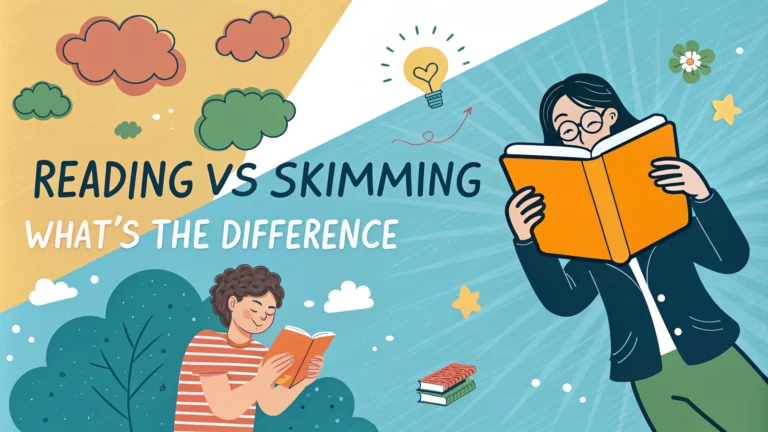Reading and skimming represent two distinct approaches to consuming written content. Understanding when to use each method can save time and improve information retention.
Both techniques serve specific purposes – **reading** focuses on deep comprehension while **skimming** helps quickly identify main ideas. Learning to switch between these methods makes you a more efficient reader.
Understanding Deep Reading
- Full engagement with text
- Focus on comprehension and retention
- Typical speed: 200-400 words per minute
- Best for complex materials and learning
The Art of Skimming
- Quick scanning for key information
- Focus on headlines, first sentences, and keywords
- Typical speed: 700+ words per minute
- Perfect for initial research and overview
When to Use Each Technique
| Reading | Skimming |
|---|---|
| Technical documents | News articles |
| Academic materials | Email newsletters |
| Fiction books | Web content |
| Important contracts | Meeting agendas |
“The key is not to read everything, but to read what matters thoroughly.” – Reading expert Peter Kump
Tools and Resources for Better Reading
Several **reading tools** and techniques can enhance both comprehension and speed. Using the right resources helps develop stronger reading habits.
Digital Reading Tools
- Speed reading apps like Spreeder and ReadMe!
- Text-to-speech software for audio reinforcement
- Note-taking apps (Evernote, OneNote) for key points
- PDF annotation tools for technical documents
Improving Your Skimming Skills
**Effective skimming** requires practice and specific techniques to extract information quickly without missing key points.
- Use your peripheral vision to scan multiple words
- Focus on first and last paragraphs
- Look for transition words and topic sentences
- Practice with newspaper articles first
Common Mistakes to Avoid
| Reading Mistakes | Skimming Mistakes |
|---|---|
| Subvocalization (reading aloud in your head) | Missing important details |
| Re-reading unnecessarily | Skimming complex materials |
| Reading without purpose | Rushing through text |
Combining Both Methods Effectively
Learning to **switch between reading styles** based on content type and purpose improves overall reading efficiency.
Tips for Combined Reading
- Skim first to preview content structure
- Deep read sections that need full attention
- Take strategic notes during both processes
- Review and summarize key points after reading
“Reading efficiency isn’t about speed – it’s about choosing the right approach for the right material.” – Dr. Richard Anderson, Reading Researcher
Remember to match your reading technique to your purpose and the complexity of the material. Practice these methods regularly to build reading proficiency.
Reading vs Skimming FAQs
Q: What’s the main difference between reading and skimming?
Reading involves thorough comprehension of text, while skimming is a rapid scanning technique to identify main ideas and key points. Reading typically captures 70-90% of content while skimming captures 30-50%.
Q: When should you use skimming instead of reading?
Skim when:
- Reviewing familiar material
- Searching for specific information
- Determining if a text needs detailed reading
- Handling large volumes of material under time constraints
Q: How does reading speed compare between skimming and normal reading?
| Reading Type | Words per Minute |
|---|---|
| Normal Reading | 200-400 |
| Skimming | 700-1000 |
Q: Does skimming affect reading comprehension?
Yes, skimming reduces comprehension to about 30-50% compared to full reading, but is more time-efficient for gathering general information.
Q: What are the best techniques for effective skimming?
- Read first and last paragraphs
- Focus on headings and subheadings
- Look for bold or italicized text
- Read topic sentences
- Scan for key terms and dates
Q: Can skimming improve overall reading speed?
Regular skimming practice can improve visual processing and pattern recognition, potentially increasing normal reading speed by 10-20%.
Q: What types of texts are best for skimming?
- News articles
- Business reports
- Academic journals
- Textbook chapters
- Online content
Q: How does skimming affect digital vs print reading comprehension?
Digital skimming typically results in 20-30% lower comprehension compared to print skimming due to increased distractions and screen fatigue.
Q: What’s the ideal reading technique for academic study?
Use a combination: skim first to identify key concepts, then read thoroughly important sections. This two-pass approach improves retention and study efficiency.
Q: Can skimming help with test preparation?
Yes, skimming is effective for quick review of previously learned material and identifying areas needing deeper study. It’s particularly useful in the final 24-48 hours before exams.



















